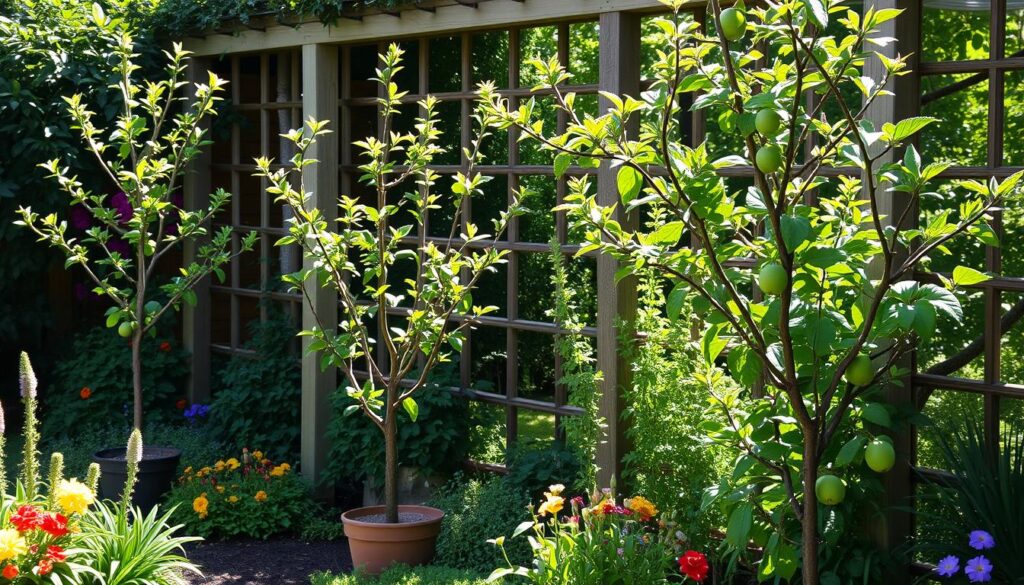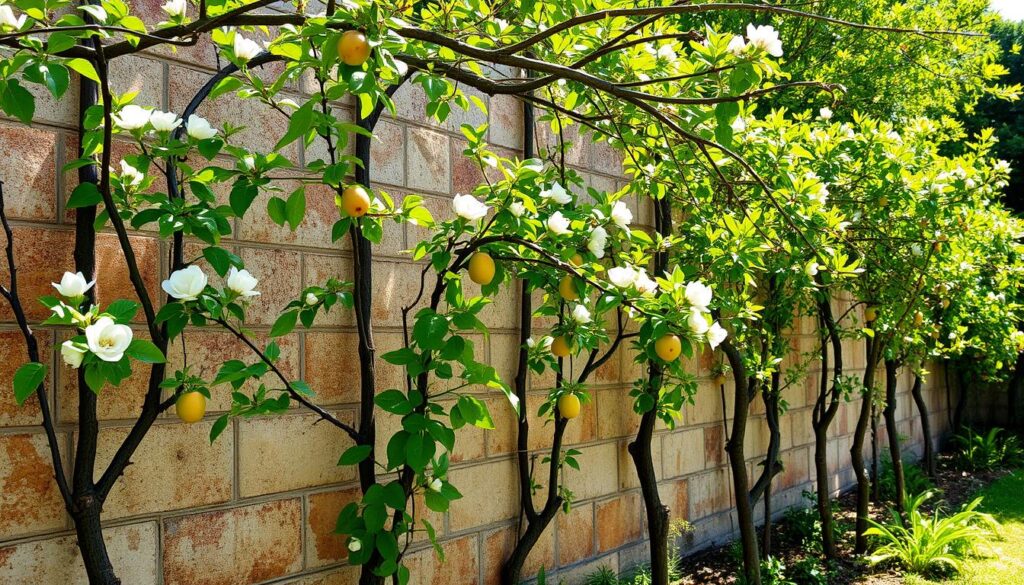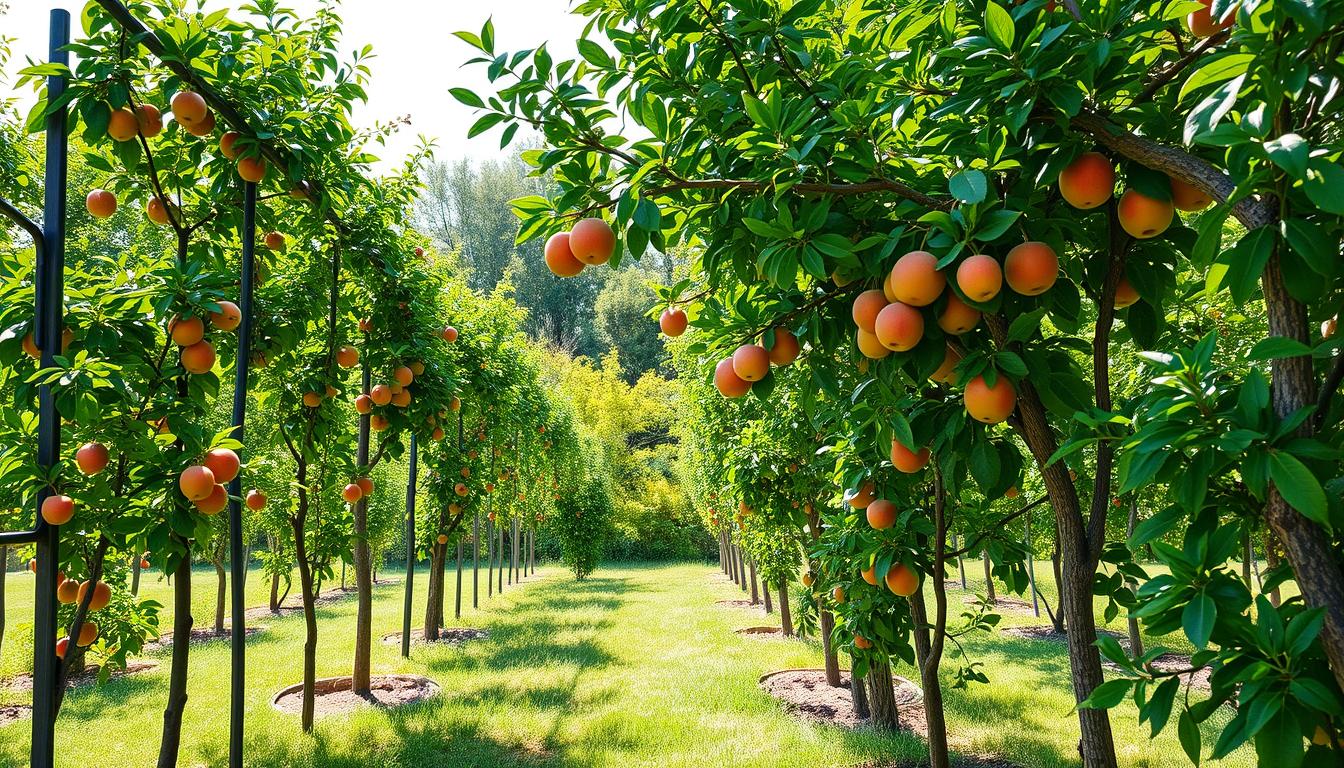Espalier is an ancient way to train fruit trees to grow against a support. It started in medieval French monasteries. This method boosts sunlight and makes gardens look beautiful.
By learning how to train fruit trees for espalier growing, I can make my garden look amazing. I also improve fruit production. Knowing espalier techniques lets me shape trees into living art that connects me to nature.
With expert pruning, timing, and care, my espalier fruit trees will thrive. This makes gardening even more rewarding.
Explore more on gardening techniquesto improve my skills and grow my passion.
Key Takeaways
- Espalier dates back to medieval France and gained popularity among chateau gardeners.
- This technique allows for efficient sunlight exposure and maximizes fruit yield.
- Various tree types, like pears and apples, are ideal for bonsai or traditional espalier designs.
- Pruning during the dormant season is essential for maintaining shape and productivity.
- Innovative methods like using clothespins or weights can aid in effective branch training.
- Understanding and mastering specialized pruning techniques is vital for long-term benefits.
The Art of Espalier: An Overview
Espalier is a mix of function and beauty, making fruit tree care more interesting. It trains trees to grow against walls, catching more sunlight and saving space. Knowing its history shows how old ideas help gardeners today.
The Historical Roots of Espalier
In medieval France, monks grew fruit trees in their gardens. They trained trees against monastery walls to use space and light well. This method has grown into an art, inspiring gardeners with many designs.
Understanding Espalier Techniques
Espalier techniques offer many ways to make fruit trees look great. Branch training and wall training help trees grow in shape. Choosing the right tree variety is key for a good design.
Pruning trees regularly, two to three times a year, keeps them looking good. This method lets gardeners create beautiful patterns. Different fruits work best with specific designs, like apples in hedges or pomegranates with multi-armed cordons.
Benefits of Espalier Techniques
Espalier techniques bring many advantages to growing fruit trees. One key benefit is how they maximize sunlight. This method lets light reach every branch, boosting photosynthesis and fruit quality.
Maximizing Sunlight Penetration
Using espalier, my trees get plenty of light, which is vital for a good harvest. The way branches are arranged captures sunlight all day. This leads to tastier fruits and faster tree growth compared to other methods.
Space-Saving Advantages
Espalier growing also saves a lot of space. It turns vertical areas into productive spots, perfect for city gardens. I can grow many trees in small spaces, making every inch count.
These trees not only save space but also get better air flow. This helps fight pests and diseases, keeping the trees healthy. In short, espalier growing makes my garden both beautiful and productive.
Choosing the Right Trees for Espalier
Choosing the right trees for espalier is key for beauty and fruit. Some trees grow better for espalier because of their shape and flexibility. Look for suitable varieties for espalier that grow well and give a good harvest.
Ideal Varieties for Espalier Growing
Apple and pear trees are top picks for espalier. Apples are easier to train because their stems grow slower than pear trees. Kieffer pears are hardy and produce fruit well without needing pollinators.
Other great choices are ‘Bartlett’ and ‘Arkansas Black’ apples. They taste great and are easy to grow.
Factors to Consider in Tree Selection
When selecting espalier trees, consider these important fruit tree selection criteria:
- Disease Resistance: Pick trees that fight off local pests and diseases well.
- Growth Habit: See if the tree fits the espalier training style.
- Rootstock: Choose dwarf or semi-dwarf rootstocks for smaller trees, perfect for tight spaces.
- Sunlight Requirements: Make sure trees get at least six hours of sun a day for best growth and fruit.
Young, healthy trees are best for training. Knowing each tree’s growth needs is crucial. It helps ensure my garden stays beautiful and productive.

How to Train Fruit Trees for Espalier Growing
Training fruit trees for espalier is a detailed process that can lead to amazing results. I start by drawing the design with chalk to make sure it’s clear before planting. This step is key for a successful training process.
Then, I dig a hole and place the rootball carefully. Guide wires are used to keep the trunk straight with the support structure. This early step is crucial for the tree’s shape and future growth.
Essential Steps for Successful Training
Pruning is vital in shaping the espalier. I cut back branches to promote growth and choose the strongest shoots for further development. This approach is a key part of espalier training.
To get the right shape, I tie the branches to the support. It’s important to keep the ties flexible so the branches can grow naturally. This setup is essential for the tree’s health and fruit production.
Training requires regular checks and adjustments. Pruning often leads to more fruiting spurs on the horizontal branches. By sticking to these steps, I can create a beautiful and fruitful garden with espaliered trees.
| Stage | Action | Outcome |
|---|---|---|
| Planning | Outline design with chalk | Clear structure for training |
| Digging | Plant rootball with guide wires | Proper alignment with support |
| Pruning | Cut back branches to stimulate growth | Strongest shoots selected |
| Tying | Secure branches to structure | Guided growth direction |
| Maintenance | Regular pruning | Increased fruiting spurs |
Designing Your Espalier Framework
Creating a great espalier framework is all about mixing creativity with practicality. The design you choose can really change how your space looks and works. Popular designs include the horizontal cordon, fan shape, and Belgian fence. Each one has its own look and fits different gardening styles and conditions.
Common Espalier Designs
The horizontal cordon is a timeless choice, with a flat look that catches the eye. The fan shape adds a lively vibe, while the Belgian fence offers a classy divider. Adding these designs to your garden not only saves space but also brings beauty to your landscape.
Setting Up the Support Structure
Building strong support for your trees is key for their health and longevity. I suggest using treated posts or sturdy walls. Make sure they have eyebolts and wires that can hold the tree’s weight and its fruit. Good planning keeps your design strong and helps your trees grow well.
| Espalier Pattern | Description | Best Suited For |
|---|---|---|
| Horizontal Cordon | A flat style trained horizontally on wires | Compact gardens, small spaces |
| Fan Shape | A design that spreads outward in a fan-like fashion | Visual interest, artistic displays |
| Belgian Fence | Interwoven branches creating a fence-like appearance | Privacy barriers, decorative separations |
Espalier Fruit Tree Pruning Techniques
Pruning is key for espalier fruit trees’ health and look. By using the right pruning methods, I help the trees grow strong and keep their shape. The first pruning lets me pick main shoots and remove branches that compete, directing energy to the leaders.
Initial Pruning Tips
In the spring, after the bloom, I keep the tree’s structure balanced. Here are some tips:
- Remove crossed or weak branches to improve airflow.
- Shorten new growth to encourage lateral branching.
- Remove any suckers that grow from the base of the tree.
Seasonal Care and Maintenance
Seasonal care for espalier trees needs constant attention. I check them regularly to keep their shape and health:
- Perform light pruning after fruit set to enhance sunlight exposure.
- Assess for pests and diseases, taking action when necessary.
- Adjust support and training ties to ensure that branches grow in the desired direction.
By following these pruning methods and caring for my trees seasonally, they can flourish and fruit well. 
Espalier Support Systems
Building a strong support system is key for espalier growth. The materials you choose can greatly affect your fruit trees’ health and training. Knowing the benefits of different options makes installing support easier.
Choosing Between Wires and Trellises
Wires and trellises each have their own perks. Wires are great for supporting branches and can be adjusted as the tree grows. Trellises, on the other hand, can make your garden look better while providing the needed support. For bigger trees, galvanized wires are often better because they’re durable and easy to put up.
Installing Your Support Framework
Setting up support for trees needs careful planning and doing. Start by anchoring posts at intervals that fit your trees’ future spread. Make sure there’s an 8 to 10-inch gap between your trees and the supports for best growth. Space the wires evenly and keep them tight during installation. This helps train the trees and keeps them stable as they grow.
| Support System | Benefits | Considerations |
|---|---|---|
| Wires | Durable, adjustable, effective for larger trees | Requires proper tension setup |
| Trellises | Decorative, stable | May take up more garden space |
Spending time on the right support system helps your espaliered trees grow well. Regular upkeep and adjustments help get the shape and growth you want for these special plants.
Common Mistakes in Espalier Growing
Starting my espalier growing journey, I quickly found many pitfalls. Mistakes can lead to disappointing results. It’s key to know what to avoid, especially over-pruning and poor support.
Over-Pruning and its Consequences
Proper pruning is crucial for your espalier trees’ health and shape. Over-pruning harms the plant’s vigor. It cuts down photosynthesis and weakens the tree’s structure.
Prune in late winter or early spring when the tree is dormant. Cut just below the lowest tier to encourage new growth. Aim for one tier per season, but some trees might grow two.
Inadequate Support Structures
I faced support failures early on. A strong support system is vital for espalier trees. Without it, branches can sag or break.
Regular checks ensure support systems grow with the tree. Start with a strong first layer before adding a second. This prevents structural problems from poor support. For more tips, check out establishing espalier trees.
Conclusion
Learning to grow espalier is a journey that needs dedication and patience. Successful espalier growing makes gardens look stunning and uses space well. It also helps trees get more sunlight, which is great for fruit.
I’ve grown six dwarf apple trees, with three planted last year and three this year. The espalier method has helped them grow strong and healthy. This has led to more fruit and better-looking trees.
By trimming branches and pruning in winter, my trees have gotten healthier and produced more fruit. If you want to try espalier, learning about tree growth and sunlight is key. For more info, check out this guide on espalier training.
Before starting your espalier project, make sure you know about soil, pests, and care. With the right support and planting at the right time, you’ll see the benefits of espalier. Your garden will be beautiful and fruitful for many years.



Leave a Reply